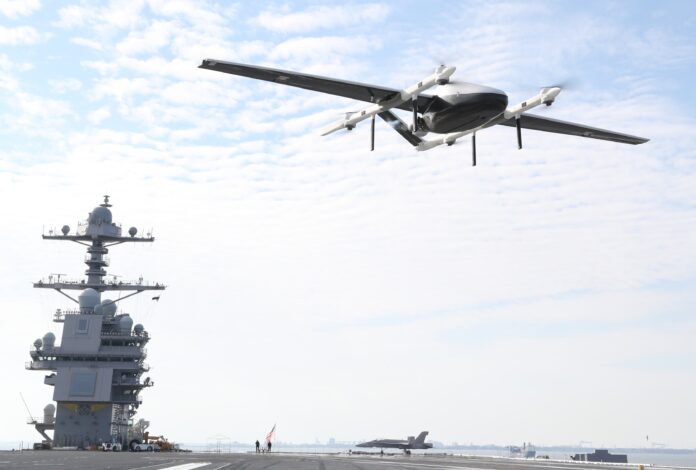
U.S. Naval Air Force Atlantic conducted a test of a logistics Unmanned Air System prototype over Naval Station Norfolk on Feb. 21, 2021. The long-range cargo transport, dubbed Blue Water UAS, is designed to operate with Naval Forces that typically operate in heavy winds over open water and require aircraft to land on pitching vessels at sea. The technology demonstrator vehicle can operate in some of these conditions and further development will be required to meet the full Naval requirement.
“The Ford Blue Water UAS supply demo is a first step in revolutionizing logistics support to maximize operational availability and lethality for these critical capital assets,” said Capt. John Bush, Director, Aircraft Material and Engineering, Naval Air Forces Atlantic.

The proof-of-concept test was successfully conducted by transporting light-weight logistical equipment from the Mid Atlantic Regional Maintenance Center (MARMC), Naval Station Norfolk on board USS Gerald R. Ford (CVN 78) while the Ford-class aircraft carrier was in-port.
“This UAS demonstration leverages cutting edge technology to enhance our logistical efficiency across the Naval Air Force.” said Rear Adm. John F. Meier, Commander, Naval Air Force Atlantic. “We have come a long way in integrating unmanned systems in Naval Aviation and the lessons learned today will help to accelerate this capability to the fleet.”
Historic data from Navy casualty reports show that warships that move to non-mission capable or partially mission capable status often do so due to logistics issues like the need for electronic parts, 90 percent of which are logistical deliveries weighing less than 50 pounds. Currently, aircraft like the MH-60 helicopters and MV-22 tilt-rotor aircraft fly these missions. Blue Water presents an opportunity to cut the cost and inefficiency of these flights.

“Carrier logistics is a complex and diverse problem set,” said Capt. Paul Lanzilotta, Gerald R. Ford’s commanding officer. “Sometimes getting a small part delivered to the ship has a big impact on the availability of an embarked system or aircraft. Having UAS like Blue Water may improve our ability to quickly meet specific logistics needs where payload and ship’s location permit.”
The Naval Air Warfare Center Aircraft Division (NAWCAD) will continue to work with its industry partners to enhance the UAS in-house with developments like folding wings for better handling and ship storage, and consider alternative air vehicle designs with advanced propulsion systems to provide greater range and payload performance, optical and infrared collision avoidance and landing systems, and navigation systems not only dependent on GPS.

Blue Water UAS
Blue Water UAS can operate from both the ship and the shore. It requires minimal maintenance and control stations are small – about the size of a shoebox or small suitcase – netting near zero infrastructure. Experimentation with the fleet will continue throughout 2021. The results of the experimentation will help the U.S.Navy decide whether to transition the technology to support fleet initiatives.
Blue Water UAS Specifications
| Manufacturer | Skyways-Austin/Texas |
| Max.Range | 500 mi |
| Max.Payload | 30 lbs |
| Propulsion | Hybrid-Electric |
Blue Water logistics UAS is equipped with propellers for vertical takeoff and landing.

Use Cases
- Ship-to-shore, shore-to-ship: Take-off and land anywhere, literally. Fly low and stay under the radar.
- Reduce load carried by troops: Fly over terrain and hazards, no lives risked. Resupply remote operations with MREs, batteries, medical supplies.
- Offshore operations: On-demand resupply capability to remote platforms. Both ways. For cost-efficient logistics at scale.


